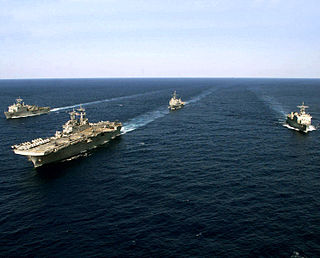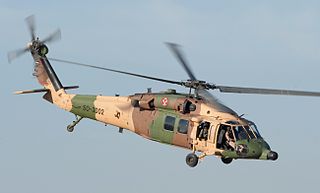
The Boeing Vertol CH-46 Sea Knight is an American medium-lift tandem-rotor transport helicopter powered by twin turboshaft engines. It was designed by Vertol and manufactured by Boeing Vertol following Vertol's acquisition by Boeing.

The Boeing CH-47 Chinook is a tandem-rotor helicopter originally developed by American rotorcraft company Vertol and now manufactured by Boeing Defense, Space & Security. The Chinook is a heavy-lift helicopter that is among the heaviest lifting Western helicopters. Its name, Chinook, is from the Native American Chinook people of Oregon and Washington state.

The Sikorsky CH-37 Mojave is an American large heavy-lift helicopter of the 1950s.

The Bell CH-146 Griffon is a multi-role utility helicopter designed by Bell Helicopter Textron as a variant of the Bell 412EP for the Canadian Armed Forces. It is used in a wide variety of roles, including aerial firepower, reconnaissance, search and rescue and aero-mobility tasks. The CH-146 has a crew of three, can carry up to ten troops and has a cruising speed of 220–260 km/h.

The Sikorsky CH-53E Super Stallion is a heavy-lift helicopter operated by the United States military. As the Sikorsky S-80, it was developed from the CH-53 Sea Stallion, mainly by adding a third engine, adding a seventh blade to the main rotor, and canting the tail rotor 20°. It was built by Sikorsky Aircraft for the United States Marine Corps. The less common MH-53E Sea Dragon fills the United States Navy's need for long-range minesweeping or airborne mine countermeasures missions, and performs heavy-lift duties for the Navy. The Sikorsky CH-53K King Stallion, which has new engines, new composite rotor blades, and a wider aircraft cabin, is set to replace the CH-53E and is beginning to enter service in the 2020s, but most of the Super Stallions are still in service as are the MH-53E Sea Dragons.

The CH-53 Sea Stallion is an American family of heavy-lift transport helicopters designed and built by the American manufacturer Sikorsky Aircraft. The Sea Stallion was originally developed in response to a request from the United States Navy's Bureau of Naval Weapons made in March 1962 for a replacement for the Sikorsky CH-37 Mojave helicopters flown by the United States Marine Corps (USMC).

The Sikorsky CH-54 Tarhe is an American twin-engine heavy-lift helicopter designed by Sikorsky Aircraft for the United States Army. It is named after Tarhe, an 18th-century chief of the Wyandot Indian tribe whose nickname was "The Crane". The civilian version is the Sikorsky S-64 Skycrane.

The Mil Mi-8 is a medium twin-turbine helicopter, originally designed by the Soviet Union in the 1960s and introduced into the Soviet Air Force in 1968. It is now produced by Russia. In addition to its most common role as a transport helicopter, the Mi-8 is also used as an airborne command post, armed gunship, and reconnaissance platform.

An amphibious ready group (ARG) of the United States Navy consists of a naval element—a group of warships known as an Amphibious Task Force (ATF)—and a landing force (LF) of U.S. Marines, in total about 5,000 people. Together, these elements and supporting units are trained, organized, and equipped to perform amphibious operations.

The Mil Mi-6, given the article number izdeliye 50 and company designation V-6, is a Soviet/Russian heavy transport helicopter that was designed by the Mil design bureau. It was built in large numbers for both military and civil use and was the largest helicopter in production until the Mil Mi-26 was put in production in 1980.

The Mil Mi-26 is a Soviet/Russian heavy transport helicopter. Its product code is Izdeliye 90. Operated by both military and civilian operators, it is the largest helicopter to have gone into serial production.

An airlift is the organized delivery of supplies or personnel primarily via military transport aircraft.

The Kawasaki C-1 is a twin-engined short-range military transport aircraft developed and manufactured by the Japanese conglomerate Kawasaki Heavy Industries. It is solely used by the Japan Air Self-Defense Force (JASDF).
Operation Mount Hope III was a top secret clandestine American military operation to capture a Soviet-made Mil Mi-25 "Hind-D" attack helicopter, an export model of the Soviet Mi-24. The aircraft had been abandoned in the conflict between Libya and Chad.

The Sikorsky CH-53K King Stallion is a heavy transport helicopter designed and produced by Sikorsky Aircraft. The King Stallion is an evolution of the long running CH-53 series of helicopters which has been in continuous service since 1966, and features three up-rated 7,500 shp (5,590 kW) engines, new composite rotor blades, and a wider aircraft cabin than its predecessors. It is the largest and heaviest helicopter in the U.S. military.

A military helicopter is a helicopter that is either specifically built or converted for use by military forces. A military helicopter's mission is a function of its design or conversion. The most common use of military helicopters is transport of troops, but transport helicopters can be modified or converted to perform other missions such as combat search and rescue (CSAR), medical evacuation (MEDEVAC), airborne command post, or even armed with weapons for attacking ground targets. Specialized military helicopters are intended to conduct specific missions. Examples of specialized military helicopters are attack helicopters, observation helicopters and anti-submarine warfare (ASW) helicopters.

The Boeing Vertol XCH-62 was a triple-turbine, heavy-lift helicopter project designed for the United States Army by Boeing Vertol. Approved in 1971, one prototype reached 95% completion before it was canceled in 1975. The prototype was scrapped in 2005.

An armed helicopter is a military helicopter equipped with aircraft ordnance. Most commonly, it is used for attacking targets on the ground. Such a helicopter could be either purposely designed for a ground-attack mission—in which case it would be more specifically categorized as an attack helicopter—or may have been previously designed for other uses, such as utility, air cargo, aerial reconnaissance, etc., with the weapons mounts being modifications, rather than part of the design of the helicopter. The purpose of the modification to an armed helicopter configuration can be field expediency during combat, the lack of military funding to develop or purchase attack helicopters, or the need to maintain the helicopter for missions that do not require the weapons.

The Australian Defence Force has operated Boeing CH-47 Chinook heavy-lift helicopters for most of the period since 1974. Thirty four of the type have entered Australian service, comprising twelve CH-47C variants, eight CH-47Ds and fourteen CH-47Fs. The helicopters have been operated by both the Royal Australian Air Force (RAAF) and Australian Army.





















